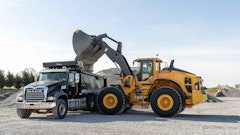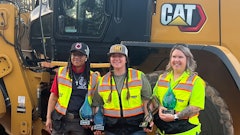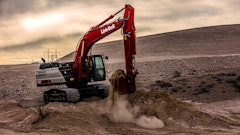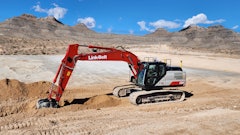Today's economy rewards those who can move a cubic yard of material at the lowest possible cost. So it pays to evaluate all of your off-road haul truck options to ensure you achieve this objective.
All off-road trucks can be placed into two categories: articulated or rigid frame. Basically, jobsite conditions dictate which type makes the most sense.
"One of the benefits of an articulated truck is its ability to go just about anywhere regardless of haul road condition. This versatility is a big advantage when working in an area where the site is constantly changing and/or wet weather is a consideration," says Ann Schreifels, articulated truck product specialist at Caterpillar. "Rigid-frame trucks have a faster top speed. So on a site with a long haul, good roads and predominantly dry conditions, rigid-frame trucks may be the best choice."
A versatile hauler
Articulated trucks are the most popular solution for construction sites due to their ability to deal with a variety of terrains and conditions.
"Jobsite versatility is a huge benefit and directly benefits utilization," says Buddy Goodman, N.A. manager, market and project support, Volvo Construction Equipment. "Articulated haulers require no haul road, can travel essentially anywhere on the site and can even operate in and through deep water."
The ability to work in a range of conditions is a huge plus. "In the construction industry, articulated trucks are constantly being moved from site to site, so contractors want to know that, regardless of ground conditions, they will have the ability to move material," says Schreifels.
This constant movement also places an emphasis on transport costs. "The rigid trucks usually require disassembly before shipment, where the articulated truck can roll directly onto the lowboy and go to the next site," says Goodman.
Traction and suspension performance are both critical in the off-road environment. "The superior traction of the all-wheel-drive articulated truck, combined with a suspension design that can keep all of the wheels on the ground in very rough terrain, make it a winner in off-road competition," says Emmett.
Goodman agrees, adding, "It's the articulated truck's ability to negotiate the adverse conditions that make the trucks unparalleled in the industry. With its 6x6 drive configuration vs. two-wheel drive for rigid trucks, it makes tough jobs look easy, and road maintenance is no longer a huge concern.
"Haulers also have the ability to operate on grades up to 45%, where rigid trucks can only handle 10% or less," he adds. "Close quarters are no problem for articulated trucks, as they have a 4-ft. advantage in turning radius."
The operating costs of an articulated truck can vary dramatically depending upon the ground conditions and grades on a particular jobsite. Factors such as the rolling resistance, which is dictated by tire choice and how far the tire sinks into the soil, influence the fuel consumption and productivity on any given site.
The owning and operating costs may be higher compared to a rigid frame truck when operated on a hardpack surface. Yet, the versatility to work in varied weather conditions may still favor an articulated truck. "At that point, you have to ask yourself if the longer working window and extra versatility offset the increased cost," says Schreifels.
Articulated enhancements
One of the latest trends in articulated truck design has been the use of higher horsepower engines. According to Ken Emmett, Terex Construction product manager, the power-to-weight ratio is a very important measure for an articulated truck, because it allows you to go faster and haul more, which increases the bottom line.
And advancements keep enhancing their capabilities. "Wet disc brakes on all wheels are an advancement being introduced into most manufacturers' trucks," says Emmett. "The driver has a feeling of security knowing he can stop a loaded hauler heading downhill without brake fade. It also reduces operating costs. A dry brake can consume upwards of 5% of the truck's purchase price over 10,000 hours. Wet brakes all but eliminate this cost and increase uptime."
Several manufacturers have also upgraded the suspension designs. For example, Volvo is launching a computer-controlled hydraulic suspension for its A35/40. "Besides dramatically improving comfort and productivity, it provides anti-roll and self-leveling functions by allowing cross flow between cylinders and back to the tank," says Goodman.
Likewise, Terex touts the benefits of its independent front suspension (IFS). "With coil over damper units and half shafts, the truck rides measurably better than non-IFS trucks," claims Emmett. "The advantage translates directly into the potential for a more comfortable ride for the operator. The reduction in vibration in the truck may also increase the life of components."
The advent of ejector bodies adds a new dimension to articulated models. "We are seeing a greater acceptance of our ejector truck design," says Schreifels. "By ejecting the load out the back of the truck on-the-go instead of stopping to raise the body, contractors are seeing faster cycle times, down-sized support equipment and the versatility to go places a raised-body truck wouldn't work (under power lines or bridges, spreading on slopes, underground mining, etc.)."
Then there is the emergence of articulated water trucks. "The adoption of articulated trucks as water trucks is a major change to the construction industry," says Emmett. "By combining the go-anywhere ability of the articulated truck with a stable, low-profile water tanker, the new breed of road maintaining water trucks is advancing quickly."
Rigid-frame trucks offer economy
In the right conditions, a 45-ton or smaller rigid-frame truck can be a cost-effective solution. "The justification is simple," says Emmett. "If the haul roads will support application of the rigid, the rigid will be less expensive to operate. But you must consider footing, road width, weather and all of the associated items that impact upon traction."
Sites with well-maintained permanent or semi-permanent roads are good candidates for a rigid-frame truck. "The ideal site for a small rigid-frame truck is a fixed location with excellent haul roads," says Schreifels. "Rigid-frame trucks have demonstrated the lowest cost per ton in applications with good haul roads. If you are worried about productivity in changing conditions, then an articulated truck may be a better fit."
It all comes down to the economics of hauling more material per cycle. Generally, rigid-frame trucks on a site are larger. "Therefore, the rigid-frame has an advantage of transporting more material per cycle," says Emmett. "And that cycle will most likely be on a smoother road. The cycles will be faster and the costs associated with operating, such as labor, fuel, maintenance and ownership, will be less per unit hauled."
Rigid trucks tend to be a more mature product than articulated trucks, but there have been some developments in this market. "Wet brakes are now standard on most brands and computerized drivetrains are common," says Emmett. "The next big leap will be with the introduction of Tier IV engines."
He adds, "There is some movement toward hybrid rigid trucks, but the development is in its infancy. However, climbing fuel prices will help push this forward."
Caterpillar recently introduced center-mounted cabs on its 40- and new 50-ton rigid-frame trucks. "The cab on all of our quarry and construction trucks (40 to 100 tons) is more spacious and has more glass area for better visibility than previous models," says Don Weinhold, market professional at Caterpillar. In addition, there are rear vision cameras for better visibility, automatic retarders and engine brakes, ground level lockouts and other upgrades, which increase the performance and safety of the current generation of rigid-frame models.
Alternative option emerges
In addition to traditional rigid-frame haul trucks, there are other unique options available, including one offered by Western Star Trucks. The company has collaborated with J&J Truck Bodies & Trailers to offer the 6900 XD 40-ton dump. It is designed to maximize shift productivity through efficient fuel consumption, fast cycle times and operator comfort.
This truck features 110,000-lb. planetary axles, a Detroit Diesel 60 Series engine, a fully automatic Allison 4500 RDS transmission and a purpose-built dump box. It boasts stable loaded top speeds of more than 40 mph in the right application.
Western Star claims the truck can be up to 35% more cost efficient than traditional off-road haulers when haul distances exceed one mile. It starts with the purchase price. Chuck Whitehead, Western Star, indicates a traditional 45-ton rigid frame haul truck starts around $450,000, while the Western Star 6900 XD dump comes in at around $375,000.
"We use much simpler components that have the same durability and focus on the efficiency," he states. "The truck stems from on-highway truck technology and engineering, which is based almost solely on fuel efficiency."
Whitehead says much of the efficiency is due to power parasitic drag. "In the transmission, there is no parasitic loss in the torque converter because you are in lockup. We use dry, drum-type brakes, so there is no inherent drag. Then instead of going with 35-in. low-pressure tires, we are using high-pressure tires at 145 psi. So we have almost no rolling resistance to our truck."
Low-pressure tires add a lot of rolling resistance, Whitehead asserts. "We are using Michelin earthmover tires with an earthmover tread, so they can get into some pretty nasty conditions," he notes. But this needs to be put into context. "It will not go where an articulated 6x6 will go."
Another advantage over traditional rigid-frame trucks is the footprint on the ground. It has a 6x4 configuration vs. the 4x2 configuration of traditional rigid haul truck. This is a benefit when backing to the dump area, says Whitehead.
The ability to customize the truck for your operation is a further differentiating factor. While it can be purchased as a standard, optimized package, there are many options available.
Whitehead admits there is a perception issue with traditional heavy equipment owners. But the truck has proven itself over many years in the mining industry. "There is nothing new about it," he states. The only difference is the truck is now being marketed as a package for the earthmoving industry.





























